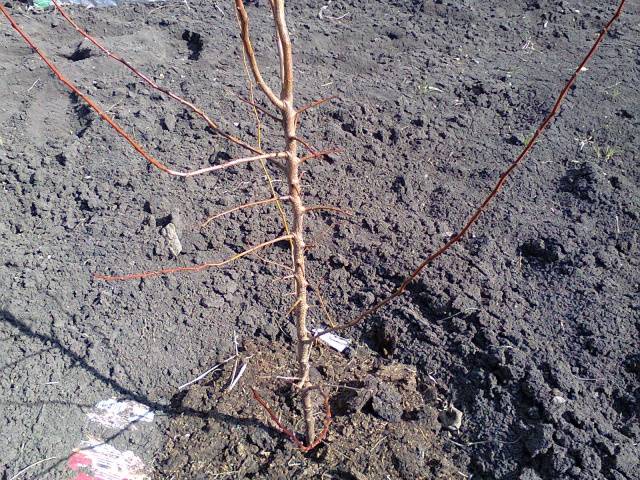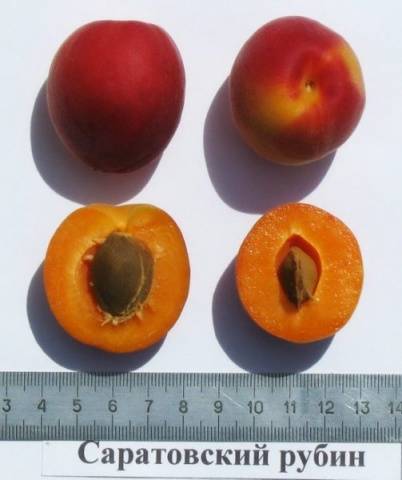Content
New varieties of apricot are spreading in central Russia and beyond. One of them is the Saratov Rubin variety, bred by a domestic breeder.
Breeding history
Apricot Saratov Rubin is a new industrial grade. The author of the variety is Alexander Mikhailovich Golubev, the founder of a private breeding nursery in Saratov.
A.M. Golubev has been breeding stone fruit and nut crops for over 30 years. The main task of the breeder was the adaptation of southern plants to the conditions of the middle zone. In addition to apricots, the nursery grows peaches, almonds, pears, plums, apple trees, honeysuckle, lemon, and pomegranate. Particular attention is paid to the frost resistance of varieties, yield, taste and presentation of fruits.
In 2010 A.M. Golubev applied for the inclusion of the Saratov Rubin in the state register. Since 2015, the variety has been listed in the State Register under the number 8952988.
Description of culture
Saratov apricot is a medium-sized tree with a spherical spreading crown. The tree grows rapidly after planting. It reaches a height of 4-5 m. The bark is rough, brown in color.
Shoots of medium length, straight, brown color. The leaves are rich green, wide, rounded, pointed at the ends, with a smooth shiny surface. The sheet plate is concave. In spring, the apricot produces white, single flowers of medium size.
Characteristics of apricots of the Saratov Rubin variety:
- medium sizes;
- weight 40-45 g;
- elliptical shape;
- light orange color;
- rough skin with pubescence;
- orange pulp of medium juiciness;
- juice without pronounced color.
Photo of apricot Saratov Rubin:
The fruits of the Saratov Rubin have a sweet and sour taste. Evaluation of taste - 4.3 points. The bones are medium-sized, elongated, easily separated from the pulp. The fruits contain 14.2% dry matter, 8.5% sugar, 1.5% acid, 1.33% pectin substances, 12.3 mg vitamin C.
The best regions for growing apricot Saratov Rubin: Nizhnevolzhsky (Saratov, Astrakhan, Kalmykia, Volgograd) and the North Caucasus.
Characteristics
When choosing a variety of apricot, take into account its frost resistance, ripening dates, frost and disease resistance.
Drought resistance, winter hardiness
The Saratov Rubin variety tolerates drought and lack of watering well. The wood is characterized by high frost resistance of wood: about -42 ° С. Fruit buds can withstand temperatures as low as -36 ° C.
Apricot is resistant to podoprevanie. The variety has a long dormant period. The tree does not freeze even after the February thaws.
Pollination, flowering period and ripening times
For gardeners, it matters whether a self-fertile apricot is a Saratov ruby or not. The variety is partially self-fertile. To obtain a high yield, it is recommended to plant nearby varieties of Dessertny Golubeva and Lakomka, which have good taste.
For the northern regions, the originator advises using frost-resistant pollinators for apricot Saratov Ruby: Manitoba 604, Zhigulevsky souvenir, Northern triumph... Breeding work is underway in Golubev's nursery, which in a few years will allow obtaining reliable pollinators for the variety.
The fruits ripen early. The crop is harvested from mid-July. Fruits have a high keeping quality. At a temperature of +5 ° C, fruits are stored for a month.
Productivity, fruiting
Subject to the rules of planting and caring for an apricot, the Saratov Rubin from one tree is removed from 95 to 115 kg of fruits. The variety begins to bear fruit early (3-4 years after planting). The yield is high and stable.
Scope of the fruit
The fruits of the Saratov variety are universal. They are consumed fresh, used to make jam, jam, compote, marshmallow and dried apricots.
Disease and pest resistance
The variety is resistant to moniliosis. Flowering branches are not subject to monilial burn, and fruits are not subject to fruit rot. No signs of clasterosporium were found on the fruits, so they always have a good presentation.
Due to its high resistance to diseases, numerous chemical treatments of the wood are not required. Therefore, apricot is suitable for growing on an industrial scale to obtain environmentally friendly products.
Advantages and disadvantages
The main advantages of the Saratov apricot:
- high frost resistance;
- self-fertility;
- early maturation;
- resistance to disease.
Disadvantages of the variety:
- mediocre fruit taste;
- a tall, spreading tree that takes up a lot of space on the site.
Landing features
The apricot is planted on time. Be sure to prepare a planting pit and improve the quality of the soil.
Recommended timing
In colder regions, apricots are planted in the spring after the snow has melted. Work is carried out before bud break.
In warm climates, planting begins in late autumn after leaf fall. The seedling will have time to take root before the cold snaps. In the middle lane, both spring and autumn planting is allowed.
Choosing the right place
The place for the apricot must meet a number of conditions:
- lack of strong wind;
- good natural light;
- light loamy soil;
- neutral or slightly alkaline soil reaction.
The culture does not like acidic soil, so liming is performed before planting. Apricots are not planted in lowlands, where cold air and moisture accumulate.
What crops can and cannot be planted next to an apricot
It is not recommended to plant the Saratov apricot next to certain crops:
- cherry;
- peach;
- Apple tree;
- pear;
- Walnut;
- raspberries, currants.
The apricot is removed from the apple tree and other tall trees at a distance of more than 4 m.
Spring flowers can be planted under the tree: primrose, tulips or daffodils. Perennial grasses grow well in the shade of trees.
Selection and preparation of planting material
For planting, annual seedlings of the Saratov Rubin variety are used. Before buying, the condition of the root system and shoots is assessed. Choose plants without mold, cracks and other defects. Before planting, the roots of the tree are slightly shortened and placed in a mash made of clay and mullein.
Landing algorithm
How to plant an apricot Saratov Rubin:
- In the fall, you need to dig a hole 70x70 cm in size and 80 cm deep.
- A drainage layer of fine gravel is poured onto the bottom of the pit.
- Fertile soil is mixed with humus in a 2: 1 ratio, then 2 kg of ash and 0.5 kg of superphosphate are added.
- A part of the earth is transferred into the pit and a seedling is placed on top.
- The roots of the plant are covered with the remaining soil.
- The tree is watered with warm water.
Follow-up care of the culture
Apricots are fed several times per season. In the spring, the soil is watered with a mullein or urea solution. When the fruits ripen, potash-phosphorus fertilizers are applied to the soil.
If a drought is established in May or June, then the apricot is watered with warm water. The tree needs moisture during the flowering period to form the ovaries.
Apricot pruning Saratov Rubin is carried out in late autumn after leaf fall.Dry, broken and weak branches are subject to elimination. Shoots older than 3 years are also cut as they lose their ability to produce crops.
To protect the tree from pests, its trunk is tied with roofing material or mesh for the winter. Young saplings are insulated with lutrasil, which acts as an insulator.
Diseases and pests, methods of control and prevention
The most dangerous diseases of apricots are shown in the table:
Type of disease | Symptoms | Ways to fight | Preventive measures |
Brown spot | Small yellow spots on the leaves that grow rapidly and turn brown. | Treatment of wood with a solution of copper sulfate. |
|
Curliness | Yellow and orange bubbles appear on the leaves, over time, the leaves fall off. | Spraying with copper-based products. |
Apricot pests are listed in the table:
Pest | Signs of defeat | Ways to fight | Preventive measures |
Aphid | The leaves on the apricot curl, black small insects accumulate on the leaves. | Treatment of trees with Fitoverm or Karbofos |
|
Moth | The caterpillars bite into the fruit, which begins to crumble. | Spraying with Chlorophos. |
Conclusion
Saratov Rubin is a worthy fruitful variety of apricot. It can be grown in private gardens and on an industrial scale, and the fruit is suitable for processing.













